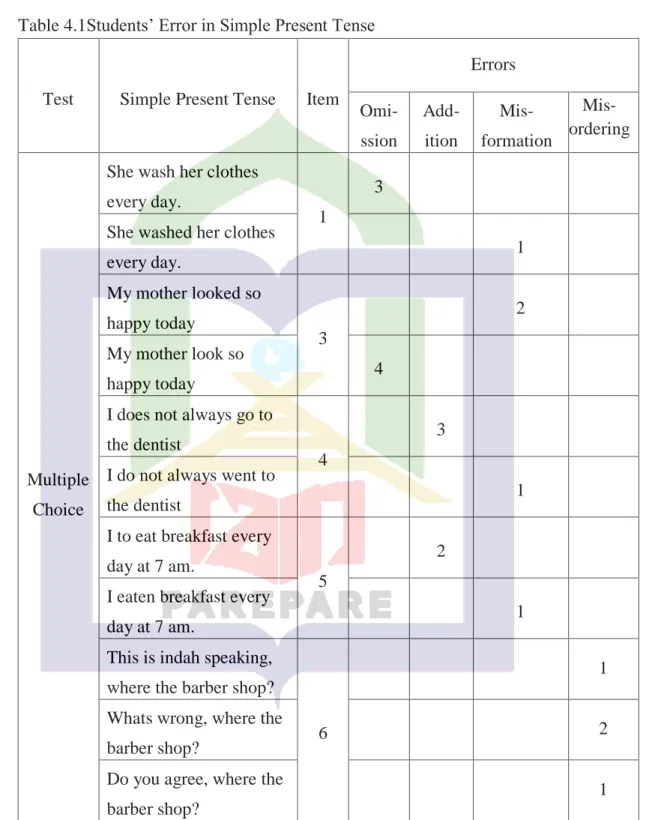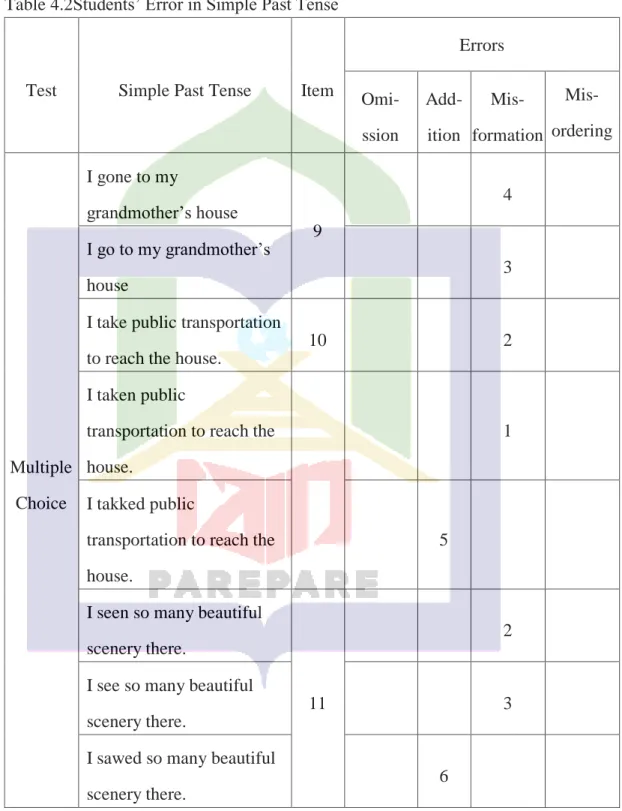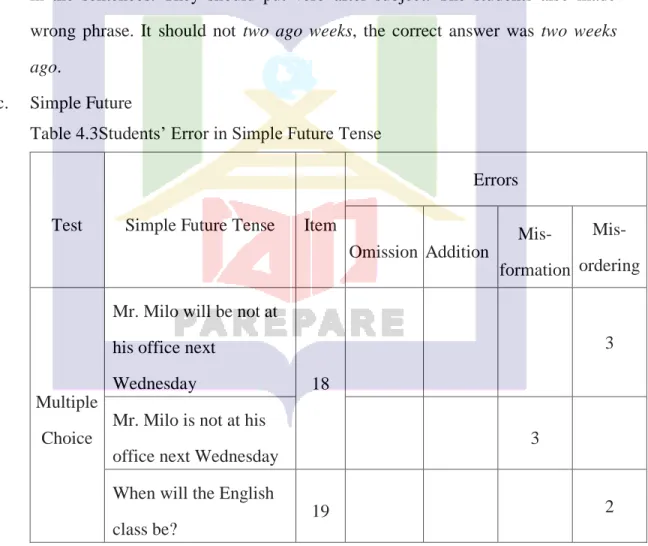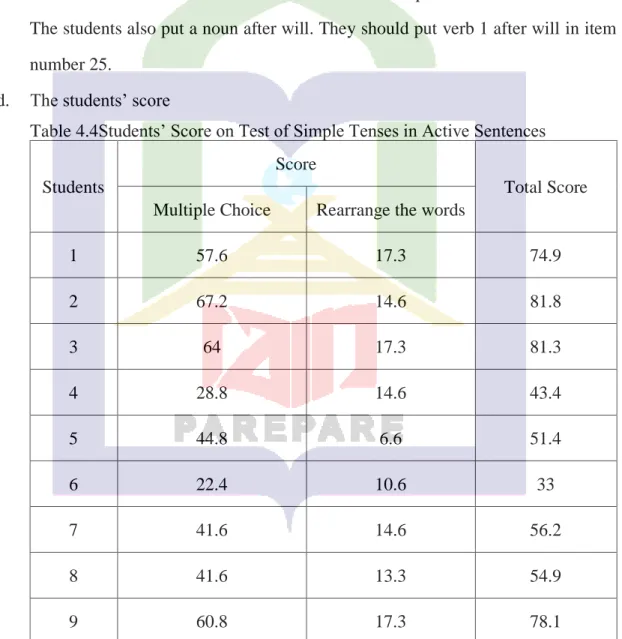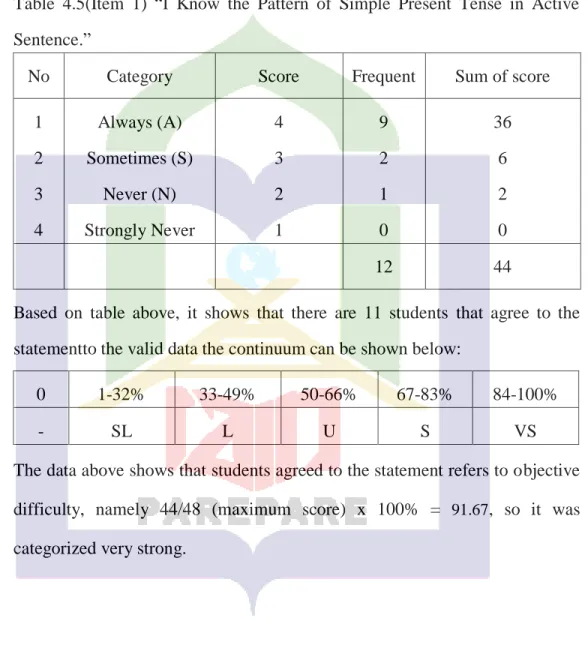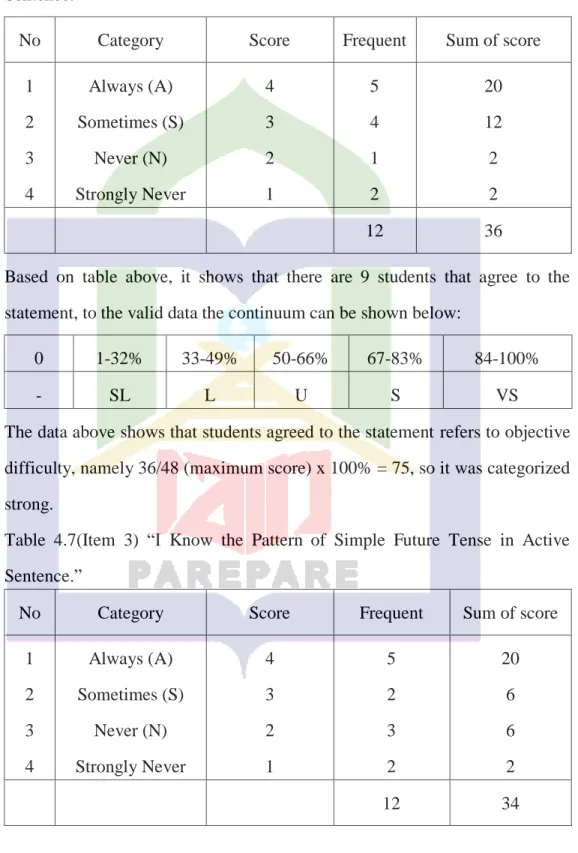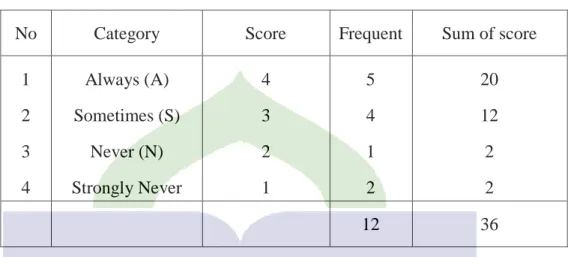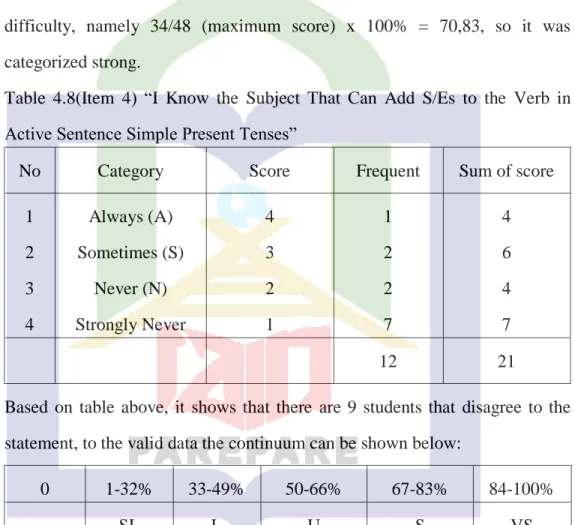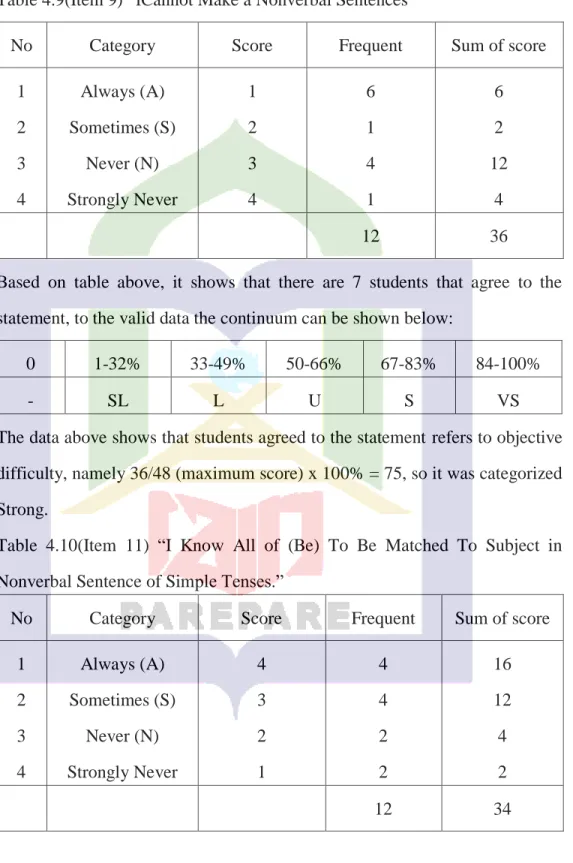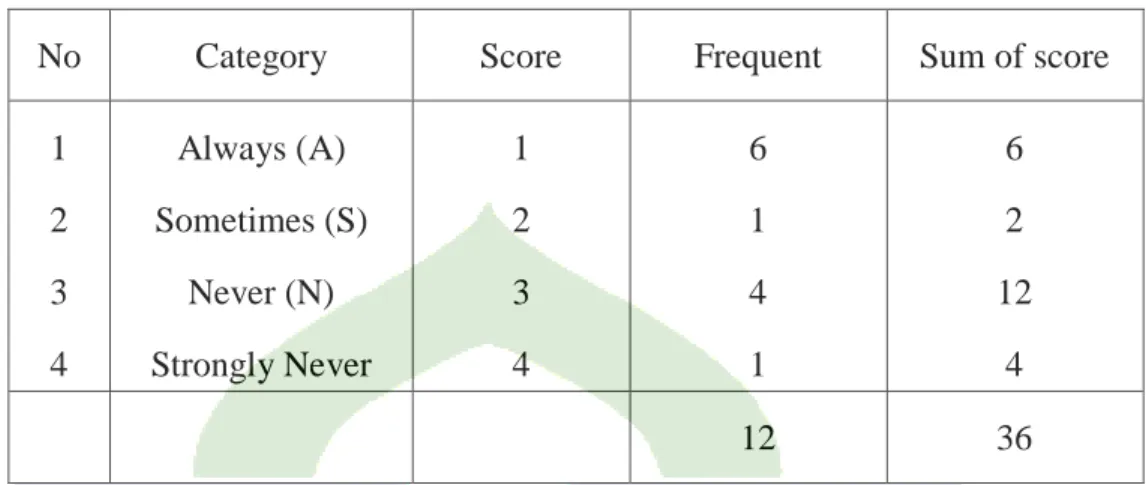Student’s simple tenses mastery and students’ difficulties in using simple tenses were two things that researcher in this research wanted to find. The researcher has done research and analyzed the data according to the data analysis guidelines, it was found.
1. The Result Test of Students’ Simple Tenses Mastery at the Second Grade of MTs DDI Buntukamassi Kab. Luwu
Being master of the simple tenses does not only know, but is also good at what it is. The simple tenses that are part of grammar is indeed a very difficultpart to learn. Mistakes and error often occur in their mastery of the simple tenses. If the mistakes and error are still committed by the students they certainly have not mastered the simple tenses.
Error is breaking the role due to lack of competence such as knowledge of the language. So that is why Errors in grammar can be find in sentences when the sentences the sentences are not in the correct structure formulation. It is an error of grammar if the sentences is not structurally correct. Those are the flawed side of learner speech and writing.1
The sentences does not fit with the grammar structure is affecting the appearance of error in the sentences. Errors occur when they cannot produce thecorrect answer in the sentences well an also lack of structure of language.
1Duley, Language Two (New York: Oxford Univercity,2002), p.99.
There are four types of error, namely omission, addition, misformation, and misordering.
a. Omission
Type of error which occurs if there are one or more items that do not appear in a formed of utterances. It is called Omission. If the sentence has missing components. Especially if the missing piece affects the meaning of the sentences. This goes into the omission group. Grammatical morphemes are more frequent to be omitted by learner rather than the contents words.
Therefore, Either morpheme or word that does not appear falls into the omission category.
b. Addition
Three types of addition error are double markings, regularization, and simple additions.Those contrast with omission. The presence of an item defines addition error that must not appear in a well-formed utterance.
First, double markings is when the auxiliary and the main verb are marked for the same tense. In the tense formation rules, tense marker is on the first verb. It is the main verb, if there is affirmative declarative sentence. The main verb is the only verb of the sentence because there is other verb in the sentence. While, it is different if a sentence needs auxiliary. Secondly, regularization is type of error that happens to the students in the use of regular and irregular forms. Thirdly, an addition error is not double marking and regularization, it is called a simple addition. For example He is my friends. The word pens should be pen without addition –s because the sentence states that pen is singular not plural.
c. Misformation
Addition error, which do not have the correct form of the morpheme or structure, is misformation. The types of misformation are regularization errors, archi – form and alternating forms. Regularization error in misformation is the same case as regularization in addition errors. It is those in which a regular marker is used in place an irregular one. For example, the word runed for run or fishes for fish. While, Archi – form is an error of using English demonstrative adjective this, that, these, those.
For example that bags which should those bags. Moreover, alternating forms is the same manner as archi form and give an alternative guide to do alternation in the sentences structure. For example, she begun diet yesterday instead of she began diet yesterday.
d. Misordering
This error is type that puts morpheme in its place. Misordering errors are characterized by the incorrect placement of a morpheme or group morpheme in an utterance. For example, he is a boy handsome, the word person is misordered. The sentences should be he is a handsome boy.
There were 30 questions that researcher used to find students simple tenses mastery by analyzing the error of the students. The researcher explained that item number part, it contained of questions number in multiple choice and rearrange the words test.
a. Simple Present Tense
Table 4.1Students’ Error in Simple Present Tense
Test Simple Present Tense Item
Errors Omi-
ssion
Add- ition
Mis- formation
Mis- ordering
Multiple Choice
She wash her clothes every day.
1
3 She washed her clothes
every day. 1
My mother looked so happy today
3
2 My mother look so
happy today 4
I does not always go to the dentist
4
3 I do not always went to
the dentist 1
I to eat breakfast every day at 7 am.
5
2 I eaten breakfast every
day at 7 am. 1
This is indah speaking, where the barber shop?
6
1 Whats wrong, where the
barber shop?
2 Do you agree, where the
barber shop?
1
She do not take a shower in her home this morning
7
4 She does take a shower
in her home this morning 3 I and my friends is in
library.
8
1 I and my friends am in
library. 4
Rearrange the word
Every tea morning father drinks my
3
1 My Every tea morning
father drinks
1
My father every drinks tea morning
1 Five garage has
4
1
Five trucks in his garage 1
Lucas his garage in five
trucks 1
Has trucks lucas in five
garage his 1
Lucas has in five his
garage trucks 1
Lucas has trucks in five
garage his 1
Lucas trucks has his in
five garage 1
Lucas in five trucks
garege his 1
Pilot will plane navigate 5
1 That plane will a pilot
navigate 1
Navigate will that plane
pilot a 1
A will navigate that pilot
plane 1
A pilot will plane
navigate that 1
A pilot navigate will that
plane 1
A pilot will that plane
navigate 1
A will that navigate pilot
plane 1
All of error types were showed by the table above. The above sentences were active simple present tense. There were 14 omission errors, 5 additions, 10 misinformation, and 23 misordering that made by students.
Omission errors were in answer options on item number 1) She wash her clothes every day. 3) My mother look so happy today. 7) She does take a shower in her home this morning and 7) She do not take a shower in her home this morning. The students’ mistake was to choose an imperfect sentence. They omitted es in the verb wash and s in the verb look. While in simple present tense, it should use V1+es/s in affirmative sentences. Furthermore, the students also omitted es in auxiliary do. It should use does because she as subject is singular and the students omitted not in negative sentence.
Additionon item number 4) Idoes not always go to the dentist and 5)I to eat breakfast every day at 7 am. The students selected auxiliary who was not late with subject. I should be with donot does. Item number 5, the students added toin
the verb. While, in negative sentence of simple present tense, it should use V1 in the sentences.
Misinformation, there were described misinformation errors in item number 1) She washed her clothes every day. 3) My mother looked so happy today, 4) I do not always went to the dentist, 5) I eaten breakfast every day at 7 am, 6) I and my friends is in library, 6) I and my friends am in library. The students made errors in some item number. They made incorrect verb in the simple present tense. They chose incorrect form of the word in the sentences. Washed, looked, went and eaten were not supposed to be in the simple present sentences. It should take v1 and if affirmative sentences should add s/es to the verb.
Misordering error is error that the incorrect placement of a morpheme or group morpheme in an utterance. Sentence structure that was out of place and it did not take place in where it should be. The students made misordering in item number 3, 4, 5 the rearrange the words. They did not rearrange the words according to the pattern of active sentence simple present tenses. For example, item number 3) Every tea morning father drinks my. It should be my father drinks tea every morning. According to the pattern of simple present tense is s+v1 s/es. It same went for number 4 and 5. It is a word arrangement error.
b. Simple Past
Table 4.2Students’ Error in Simple Past Tense
Test Simple Past Tense Item
Errors Omi-
ssion
Add- ition
Mis- formation
Mis- ordering
Multiple Choice
I gone to my
grandmother’s house
9
4 I go to my grandmother’s
house
3 I take public transportation
to reach the house.
10 2
I taken public
transportation to reach the house.
1
I takked public
transportation to reach the house.
5
I seen so many beautiful scenery there.
11
2 I see so many beautiful
scenery there.
3 I sawed so many beautiful
scenery there.
6
when I comed her house
12
6
when I come her house 1
when I coming her house 1
She give me her delicious food
13
3 She gift me her delicious
food
3
We at together
14
7
we eat together 1
Did you watched Harry Potter movie yesterday?
15
8 Did you watches Harry
Potter movie yesterday?
1 When I getting up, it is
raining 5 minutes ago.
16
2 When I gets up, it is
raining 5 minutes ago.
1 When I get up, it is raining
5 minutes ago.
1 They listen this music two
hours ago.
17
2 1
They listening this music two hours ago.
1
They be listen this music two hours ago.
1
Rearrange the words
Visited two ago they a farm
1
1 They visited a farm weeks
ago 1
They two weeks visited a
farm ago 1
They visited two ago a farm
weeks 1
They visited two ago a
farm weeks 1
They visited two ago a
farm weeks 1
They visited a farm two
ago weeks 1
Omission was found in item number 17)They listen this music two hours ago.The students omitted ed in the verb listen. Meanwhile in the simple present tense, it should be V2. It should add –ed or preterit to the irregular verb.
Addition errors were appeared in items number 10) I takked public transportation to reach the house. 11) I sawed so many beautiful scenery there.
12) when I comed her house. 12) when I coming her house. 15) Did you watched Harry Potter movie yesterday?.There were unnecessary addition that students have made. For example, they added edto the word saw and watch. This should not have been necessary because saw was the preterit of see. While, adding ed was true, if the sentence was positive sentence. Negative and interrogative sentences should use bare verb because it was accompanied by auxiliary “did”.
Misinformations were found in items number of multiple choice 9) I gone to my grandmother’s house, 10) I taken public transportation to reach the house, The students made errors by choosing a wrong answer. They made wrong form in the verb gone, taken. It should not use v3 in active sentences of simple past tense.
The students made some misordering errors. It showed in answer options of items number 13) She gift me her delicious food anditem number of rearrange the words 1) They visited a farm two ago weeks. The students did mistake placement in the sentences. They should put verb after subject. The students also made wrong phrase. It should not two ago weeks, the correct answer was two weeks ago.
c. Simple Future
Table 4.3Students’ Error in Simple Future Tense
Test Simple Future Tense Item
Errors
Omission Addition
Mis- formation
Mis- ordering
Multiple Choice
Mr. Milo will be not at his office next
Wednesday 18
3
Mr. Milo is not at his office next Wednesday
3 When will the English
class be?
19 2
when will the English class be began?
1
I bought a jacket 20 1
They will accompany me now
21
3 They will accompany
me yesterday
2 They will celebrated
my birthday here.
22
2 They will celebrating
my birthday here.
2 They will celebrates my
birthday here.
3 Tomorrow, the earth
will at the closest point to the sun, so the temperature will be hot.
23
4
Tomorrow, the earth is at the closest point to the sun, so the temperature be hot.
1
Jennie invites all of his friends to the
celebration next week.
24 1
Jennie invited all of his friends to the
celebration next week.
1
Karina and Wendy will not participates in music competition at school next month.
25
4
Karina and Wendy will not participation in music competition at school next month.
1
Rearrange the words
The brother will receive award tomorrow?
2
1 Receive will brother
tomorrow award your the
1 Will the you receive
tomorrow award
brother.?
1 Will brother award your
receive? 1
Will the award your brother receive tomorrow
1 Will your brother award
the receive tomorrow 1
Will receive brother tomorrow award your the
1 Will your brother award
yourthe receive tomorrow
1 Will the brother award
receive tomorrow 1
Omission, the students omitted “to be” in item number 23) Tomorrow, the earth will at the closest point to the sun, so the temperature will be hot.This error was made by students. They lost a part of simple future its self. The nonverbal of simple future tense should use will+be.
The addition errors were appeared in item numbers of multiple choice 22) They will celebrated my birthday here. 22) They will celebrating my birthday here. 22) They will celebrates my birthday here. 24) Karina and Wendy will not participates in music competition at school next month.The students added ed, - ing, es/e to the word “celebrate” and “participate”. The verbal sentences of simple future tense should use will+ v1 but the students made affirmative and present participle verbs.
There were some of misinformation in simple future tense items.18) Mr.
Milo is not at his office next Wednesday, 20) I bought a jacket, 21) They will accompany me yesterday, 24) Jennie invited all of his friends to the celebration next week. The students have chosen a wrong answer selection. For example, on the sentence there was time signal next Wednesday that signified a future sentence but the students made wrong form in the verb is, bought, invited. It
should will, will buy, and will invite. Because simple future tense has pattern will+v1.
The misordering errors were found in item number of multiple choice 25) Karina and Wendy will not participation in music competition at school next month.While, the rearrange the word was in item number 2) Will the award your brother receive tomorrow. The students did mistake placement in the sentences.
The students also put a noun after will. They should put verb 1 after will in item number 25.
d. The students’ score
Table 4.4Students’ Score on Test of Simple Tenses in Active Sentences Students
Score
Total Score Multiple Choice Rearrange the words
1 57.6 17.3 74.9
2 67.2 14.6 81.8
3 64 17.3 81.3
4 28.8 14.6 43.4
5 44.8 6.6 51.4
6 22.4 10.6 33
7 41.6 14.6 56.2
8 41.6 13.3 54.9
9 60.8 17.3 78.1
10 38.4 9.3 47.7
11 38.4 10.6 49
12 32 8 40
According to the table above, it explains that out of 12 students at the second grade of MTs DDI Buntukamassi. There are only 4 students who get the score minimum passing grade. While, the minimum passing grade at the second grade of MTs DDI BuntukamassiKab. Luwu is 70.
e. Percentage of the test
The researcher got the percentage of students’ simple tenses mastery, the formula used is as follows:
P = 𝟒
𝟏𝟐× 100%
= 33.3 %
Students have been given test to know their ability in mastering simple tenses. Then analyze their simple tenses mastery through the error created and has gained the value of all the students at the second grade of MTs DDI BuntukamassiKab. Luwu. After the presentation of test isobtained 33.3%. There are only 4 students who were able to score above average.
2. The result of Questionnaire of Students’ Difficulties in Using Simple Tenses based on Dekesysar’s theory.
a. Objective difficulties
Table 4.5(Item 1) “I Know the Pattern of Simple Present Tense in Active Sentence.”
No Category Score Frequent Sum of score
1 2 3 4
Always (A) Sometimes (S)
Never (N) Strongly Never
4 3 2 1
9 2 1 0
36 6 2 0
12 44
Based on table above, it shows that there are 11 students that agree to the statementto the valid data the continuum can be shown below:
0 1-32% 33-49% 50-66% 67-83% 84-100%
- SL L U S VS
The data above shows that students agreed to the statement refers to objective difficulty, namely 44/48 (maximum score) x 100% = 91.67, so it was categorized very strong.
Table 4.6(Item 2) “I Know the Pattern of Simple Past Tense in Active Sentence.”
No Category Score Frequent Sum of score
1 2 3 4
Always (A) Sometimes (S)
Never (N) Strongly Never
4 3 2 1
5 4 1 2
20 12 2 2
12 36
Based on table above, it shows that there are 9 students that agree to the statement, to the valid data the continuum can be shown below:
0 1-32% 33-49% 50-66% 67-83% 84-100%
- SL L U S VS
The data above shows that students agreed to the statement refers to objective difficulty, namely 36/48 (maximum score) x 100% = 75, so it was categorized strong.
Table 4.7(Item 3) “I Know the Pattern of Simple Future Tense in Active Sentence.”
No Category Score Frequent Sum of score
1 2 3 4
Always (A) Sometimes (S)
Never (N) Strongly Never
4 3 2 1
5 2 3 2
20 6 6 2
12 34
Based on table above, it shows that there are 7 students that agree to the statement, to the valid data the continuum can be shown below:
0 1-32% 33-49% 50-66% 67-83% 84-100%
- SL L U S VS
The data above shows that students agreed to the statement refers to objective difficulty, namely 34/48 (maximum score) x 100% = 70,83, so it was categorized strong.
Table 4.8(Item 4) “I Know the Subject That Can Add S/Es to the Verb in Active Sentence Simple Present Tenses”
No Category Score Frequent Sum of score
1 2 3 4
Always (A) Sometimes (S)
Never (N) Strongly Never
4 3 2 1
1 2 2 7
4 6 4 7
12 21
Based on table above, it shows that there are 9 students that disagree to the statement, to the valid data the continuum can be shown below:
0 1-32% 33-49% 50-66% 67-83% 84-100%
- SL L U S VS
The data above shows that students agreed to the statement refers to objective difficulty, namely 21/48 (maximum score) x 100% = 43,75, so it was categorized Low.
Table 4.9(Item 9)“ ICannot Make a Nonverbal Sentences”
No Category Score Frequent Sum of score
1 2 3 4
Always (A) Sometimes (S)
Never (N) Strongly Never
1 2 3 4
6 1 4 1
6 2 12
4
12 36
Based on table above, it shows that there are 7 students that agree to the statement, to the valid data the continuum can be shown below:
0 1-32% 33-49% 50-66% 67-83% 84-100%
- SL L U S VS
The data above shows that students agreed to the statement refers to objective difficulty, namely 36/48 (maximum score) x 100% = 75, so it was categorized Strong.
Table 4.10(Item 11) “I Know All of (Be) To Be Matched To Subject in Nonverbal Sentence of Simple Tenses.”
No Category Score Frequent Sum of score
1 2 3 4
Always (A) Sometimes (S)
Never (N) Strongly Never
4 3 2 1
4 4 2 2
16 12 4 2
12 34
Based on table above, it shows that there are 8 students that agree to the statement, to the valid data the continuum can be shown below:
0
1-32% 33-49% 50-66% 67-83% 84-100%
- SL L U S VS
The data above shows that students agreed to the statement refers to objective difficulty, namely 34/48 (maximum score) x 100% = 70,83, so it was categorized Strong.
Table 4.11(Item13)“ ICannot Detect Simple Tenses Through the Time Signal”.
No Category Score Frequent Sum of score
1 2 3 4
Always (A) Sometimes (S)
Never (N) Strongly Never
4 3 2 1
5 1 2 4
20 3 6 4
12 33
Based on table above, it shows that there are 6 students that agree to the statement, to the valid data the continuum can be shown below:
0 1-32% 33-49% 50-66% 67-83% 84-100%
- SL L U S VS
The data above shows that students agreed to the statement refers to objective difficulty, namely 33/48 (maximum score) x 100% = 68,75, so it was categorized Strong.
Table 4.12(Item 14) “I Am Able To Change Positive Sentence into Negative Sentence”.
No Category Score Frequent Sum of score
1 2 3 4
Always (A) Sometimes (S)
Never (N) Strongly Never
4 3 2 1
2 2 2 6
8 6 4 6
12 24
Based on table above, it shows that there are 8 students that disagree to the statement, to the valid data the continuum can be shown below:
0 1-32% 33-49% 50-66% 67-83% 84-100%
- SL L U S VS
The data above shows that students agreed to the statement refers to objective difficulty, namely 24/48 (maximum score) x 100% = 50, so it was categorized Undedicated.
Table 4.13(Item 15)“I Am Able To Change Positive Sentence into Interrogative Sentence”.
No Category Score Frequent Sum of score
1 2 3 4
Always (A) Sometimes (S)
Never (N) Strongly Never
4 3 2 1
2 2 3 5
4 6 6 5
12 21
Based on table above, it shows that there are 8 students that disagree to the statement, to the valid data the continuum can be shown below:
0 1-32% 33-49% 50-66% 67-83% 84-100%
- SL L U S VS
The data above shows that students agreed to the statement refers to objective difficulty, namely 21/48 (maximum score) x 100% = 43,75, so it was categorized Low.
Table 4.14(Item 17)”I Cannot Distinguish Between Verbal And Nonverbal Sentence of Simple Tenses.”
No Category Score Frequent Sum of score
1 2 3 4
Always (A) Sometimes (S)
Never (N) Strongly Never
4 3 2 1
5 1 4 2
20 3 4 2
12 29
Based on table above, it shows that there are 6 students that agree to the statement, to the valid data the continuum can be shown below:
0 1-32% 33-49% 50-66% 67-83% 84-100%
- SL L U S VS
The data above shows that students agreed to the statement refers to objective difficulty, namely 29/48 (maximum score) x 100% = 60,41, so it was categorized Undedicated.
b. Subjective difficulties
Table 4.15(Item 5) “ ILike English Although It Is Difficult”
No Category Score Frequent Sum of score
1 2 3 4
Always (A) Sometimes (S)
Never (N) Strongly Never
4 3 2 1
8 2 1 1
32 6 2 1
12 41
Based on table above, it shows that there are 10 students that agree to the statement, to the valid data the continuum can be shown below:
0 1-32% 33-49% 50-66% 67-83% 84-100%
- SL L U S VS
The data above shows that students agreed to the statement refers to subjective difficulty, namely 41/48 (maximum score) x 100% = 85,42, so it was categorized Very Strong
Table 4.16(Item 6) “I Am Able To Apply the Simple Tenses in Speaking”
No Category Score Frequent Sum of score
1 2 3 4
Always (A) Sometimes (S)
Never (N) Strongly Never
4 3 2 1
0 0 1 11
0 0 2 11
12 13
Based on table above, it shows that all of students disagree to the statement, to the valid data the continuum can be shown below:
0 1-32% 33-49% 50-66% 67-83% 84-100%
- SL L U S VS
The data above shows that students agreed to the statement refers to subjective difficulty, namely 13/48 (maximum score) x 100% = 27,08 so it was categorized Strongly Low.
Table 4.17(Item 7) “I Am Difficult Making the Sentences of Simple Tenses without Look at the Pattern”
No Category Score Frequent Sum of score
1 2 3 4
Always (A) Sometimes (S)
Never (N) Strongly Never
1 2 3 4
5 2 1 4
5 4 3 16
12 28
Based on table above, it shows that there are 7 students that agree to the statement, to the valid data the continuum can be shown below:
0 1-32% 33-49% 50-66% 67-83% 84-100%
- SL L U S VS
The data above shows that students agreed to the statement refers to subjective difficulty, namely 28/48 (maximum score) x 100% = 58,33, so it was categorized Undedicated.
Table 4.18(Item 8) “I Know the Meaning of the Three Simple Tenses in Active Sentences”
No Category Score Frequent Sum of score
1 2 3 4
Always (A) Sometimes (S)
Never (N) Strongly Never
4 3 2 1
1 1 5 5
4 3 10
5
12 22
Based on table above, it shows that there are 10 students that disagree to the statement, to the valid data the continuum can be shown below:
0 1-32% 33-49% 50-66% 67-83% 84-100%
- SL L U S VS
The data above shows that students agreed to the statement refers to subjective difficulty, namely 22/48 (maximum score) x 100% = 45,83, so it was categorized Low.
Table 4.19(Item 10) “I Do Not Understand the Three of Simple Tenses Because They Have Different Pattern, Meaning, and Pronunciation”
No Category Score Frequent Sum of score
1 2 3 4
Always (A) Sometimes (S)
Never (N) Strongly Never
1 2 3 4
5 1 1 5
5 2 3 20
12 30
Based on table above, it shows that there are 6 students that agree to the statement, to the valid data the continuum can be shown below:
0 1-32% 33-49% 50-66% 67-83% 84-100%
- SL L U S VS
The data above shows that students agreed to the statement refers to subjective difficulty, namely 30/48 (maximum score) x 100% = 62,50, so it was categorized Undedicated.
Table 4.20(Item 12) “I Am Not Excited To Discuss About Simple Tenses with Friends”
No Category Score Frequent Sum of score
1 2 3 4
Always (A) Sometimes (S)
Never (N) Strongly Never
4 3 2 1
4 1 4 3
16 3 8 3
12 30
Based on table above, it shows that there are 7 students that disagree to the statement, to the valid data the continuum can be shown below:
0 1-32% 33-49% 50-66% 67-83% 84-100%
- SL L U S VS
The data above shows that students agreed to the statement refers to subjective difficulty, namely 30/48 (maximum score) x 100% = 62,50, so it was categorized Undedicated.
Table 4.21(Item 16) “I Am Lazy Learning Simple Tenses because of Its Complex Patterns”
No Category Score Frequent Sum of score
1 2 3 4
Always (A) Sometimes (S)
Never (N) Strongly Never
1 2 3 4
2 1 2 7
2 2 6 28
12 38
Based on table above, it shows that there are 9 students that disagree to the statement, to the valid data the continuum can be shown below:
0 1-32% 33-49% 50-66% 67-83% 84-100%
- SL L U S VS
The data above shows that students agreed to the statement refers to subjective difficulty, namely 38/48 (maximum score) x 100% = 79.17, so it was categorized Strong.
Table 4.22(Item 18) “I Cannot Use Simple Tenses Because I Do Not Know the Verb”
No Category Score Frequent Sum of score
1 2 3 4
Always (A) Sometimes (S)
Never (N) Strongly Never
1 2 3 4
11 0 1 0
11 0 3 0
12 14
Based on table above, it shows that there are 11 students that agree to the statement, to the valid data the continuum can be shown below:
0 1-32% 33-49% 50-66% 67-83% 84-100%
- SL L U S VS
The data above shows that students agreed to the statement refers to subjective difficulty, namely 14/48 (maximum score) x 100% = 29.17, so it was categorized Strongly Low.
Table 4.23(Item 19) “I Cannot Make Active Sentences of Simple Tenses Because I Do Not Have a lot of Vocabulary”
No Category Score Frequent Sum of score
1 2 3 4
Always (A) Sometimes (S)
Never (N) Strongly Never
1 2 3 4
12 0 0 0
12 0 0 0
12 12
Based on table above, it shows that there are 12 students that agree to the statement, to the valid data the continuum can be shown below:
0 1-32% 33-49% 50-66% 67-83% 84-100%
- SL L U S VS
The data above shows that students agreed to the statement refers to subjective difficulty, namely 12/48 (maximum score) x 100% = 25, so it was categorized Strongly Low.
Table 4.24(Item 20) “I Do Not Understand Simple Tenses Despite Being Explained Over And Over Again”.
No Category Score Frequent Sum of score
1 2 3 4
Always (A) Sometimes (S)
Never (N) Strongly Never
1 2 3 4
2 4 3 3
2 8 9 12
12 31
Based on table above, it shows that there are 6 students that agree to the statement, to the valid data the continuum can be shown below:
0 1-32% 33-49% 50-66% 67-83% 84-100%
- SL L U S VS
The data above shows that students agreed to the statement refers to subjective difficulty, namely 31/48 (maximum score) x 100% = 64,58, so it was categorized Low.
Table 4.25The Accumulation of each Difficultyof Dekeysar’s Theory can be seen in the table below:
No Students’ difficulty Value
1 Objective Difficulty 55
2 Subjective Difficulty 45
The researcher showed the diagram in order to be easy for understanding the students’ difficulties in using simple tenses.
[CATEGORY NAME]
55 [CATEGORY
NAME]
45
The Students' difficulties of Dekeysar’s Theory
Objective Difficulties Subjective Difficulties
B. Discussions
1. The Students’ Simple Tenses Mastery in Active Sentences
Tenses have specific rules that emphasize the use of the verb associated with the time of use. In this research, the researcher want to know the students simple tenses mastery especially simple present tense, simple past tense and simple future tense. It was done by analyzing students’ error in using simple tenses on active sentences. The students said master of simple tenses,they were no longer performing error and mistakes in using the simple tenses. The researcher analyzed the students’ simple tenses mastery by giving the test.
The researcher found out the students at the second grade of MTs DDI Buntukamassi made error in using simple present tenses, simple past tense and simple future tenses. The students made errors categorized 20 in omission, 42 in addition, 49 in misinformation, and 57 in misorderin.
All the errors were made by students. In omission, students made mistake of omitting several letters on words and words in active sentences of simple present tense. This affected perfection and the meaning of the sentences.
Some students have tendency for omitting es/s in the verb. This was because of they still cannot detect affirmative sentences correctly. It also happed because students were unaware of the singular subject and plural subject.
Then in the simple past tense, the students omitted –ed in the regular verb. If the preterit is regular verb, it should add ed/d depending on the verb.
Meanwhile, in the simple future tenses, there were students who omitted to be in nonverbal sentences. This error occurred because of the students had difficulty distinguishing verbal and nonverbal sentences and they have not mastered the simple tenses pattern that the research explained in chapter II.
In addition errors, Almost all the students did this error. This is happening because they do not understand the rule of simple tenses in active sentences. Many errors occur to the verb in sentences. Any additional incidents should be avoided. They do not know the verb and the corresponding additions to the verb in simple tenses.
Misinformation errors were error who a lot of students did. This error is the kind of addition errors which do not have the correct form of the morpheme or structure. The students made the same errors in the simple present, past and future tense. They added ed, es to the verb that was not in accordance with the rules of each of tenses. The kind of error that students did, they chose incorrect verbs in each sentence of tense. For example, past participle verb was put in active sentences of simple present tense. It does not
fit the pattern in chapter II that should fit the pattern S + V1 s/es + O/Adverb.
The students also made the mistake of picking a time signal that corresponds with tenses based on table 2.1 time signal of simple tenses.
Then, misordering errors, this error appeared in the rearrange words test.
The incorrect placement of morpheme or group morphed in an utterance was made by the students. This error occurred on the three simple tenses. The morpheme in this error do not take place in where it should be. The students formulated words out of harmony with the simple tenses’ sentences structure.
All the simple tenses have meaning and rules. If the pattern is inconformity then the meaning of the sentences cannot be conveyed. Simple present tense with a simple present explanation, simple past tense with everything in the past and simple future with the events predicted to occur in the future.
Based on the explanation above, the students at the second grade of MTs DDI Buntukamassi were still full of error and mistake using simple tenses.
This made it clear that the students have not mastered the simple tenses both in term of use, structure and meaning of simple tenses themselves.
Furthermore, from the students test analysis, it was found that only 4 of the 12 students at the second grade of MTs DDI Buntukamassi had attained score minimum passing grade. It was obtained 33.3%. Therefore, the level of students’ simple tenses mastery of the second grade MTs DDI Buntukamassi was poor based on the weighted score of assessment criteria. The simple tenses mastery of students below average and the students at the second grade MTs DDI Buntukamassi have not yet mastered the simple tenses well.
2. The Students’ Difficulties in Using Simple Tenses
Based on the chapter II, objective difficulty concerns the difficulty of the grammatical rule itself. It can be show when they makes error in the sentences in writing or speaking. These difficulties have been faced by students. While, the subjective difficulty is the students experience in studying English that set in actual difficulty. According to the diagram pie in the finding above, it was about 55% the objective difficulties and 45% subjective difficulties who faced by students at the second grade of MTs DDI Buntukamassi.
a. Objective Difficulties
In the finding above, the researcher conducted questioner via google form for the students at the second grade of MTs DDI Buntukamassi. The researcher found their difficulties in using simple tenses. It can be concluded that the objective difficulties were faced by students:
First, the students at second grade of MTs DDI Buntukamssi have known the pattern of the active sentences of simple tenses. They almost knew the pattern of simple present tense. It showed at the finding above, that 11out of 12 students agreed on the statement (1)“Saya mengetahui pola dari simple present tense dalam kalimat aktif”. While, there are some of them did not know the pattern of simple past tense and future tense. It showed 9out of 12 students who agreed on the statement(2) “Saya mengetahui pola dari simple past tense kalimat aktif” and 7students agreed on the statement (3) “Saya mengetahui pola dari simple future tense kalimat aktif”. Therefore, the researcher concluded that there were still some students did not know the pattern of simple tenses.
The second, the statement (4) “Saya mengetahui subject yang dapat penambahan s/es pada kata kerja dalam kalimat aktif simple present tense”
has gotten 9out of 12 students disagreed. It meant that the students at the second grade of MTs DDI Buntukamassi were difficulty in adding es/s in the active sentence of simple tenses. They also did not know to make nonverbal sentences. It showed 7 students agreed in the statement (9) “Saya tidak mampu membuat kalimat nonverbal”. While, there were 8 students agreed in the statement (11) Saya mengetahui semua pasangan (be) untuk subject pada kalimat nonverbal simple tenses. It meant some of students still confused using (be) with suitable subject in nonverbal sentences of simple tenses.
The third, the researcher found 6 students who agreed on this statement (13) Saya tidak dapat mendeteksi simple tenses melalui time signal. Then, in the item number (14) Saya mampu mengubah kalimat positive menjadi kalimat negative the percentage of simple past and future tense, there were 8 students who disagreed.And also in the item number (15) Saya mampu mengubah kalimat positive menjadi kalimat introgative. The students disagreed on the statement. It was 8 students. Whereas on the item number (17) Saya tidak dapat membedakan kalimat verbal dan nonverbal simple tenses, there were 6 out of 12 students who agreed. Moreover, the researcher concluded that some students faced difficulties in changing positive sentences into negative and interrogative sentences. Some of them cannot identify the type of tenses by time signal too. The differences of verbal and nonverbal sentences cannot been understated by some students at the second grade of MTs DDI Buntukamassi.
b. Subjective difficulties
The second difficulty of Dekeysar’s theory is subjective. The researcher found the students’ subjective difficulty with questioner via google form.
There were 10 items that related to the subjective difficulties. The difficulty is based on the individual learners experience in second language learning.
The item (5)Saya menyukai Bahasa Inggris walapun sulit untuk dipelajari. There were 10 out of 12 students agreed on the statetment. The students have an interest in English but the student’s difficulty applying it in speaking. Thiswas confirmed on item (6) Saya mampu menerapkan ketiga simple tenses dengan baik dalam bericara.There were 12 students who disagree of this statement.
The difficulty is faced by students, it is about understanding the meaning of simple tenses. It shows in item (8) Saya mengetahui makna ketiga simple tenses dalam kalimat aktif. There 10 students who disagree on the statement.
Simple tenses have different patterns of tenses and type of sentences. So that, understanding all their meaning will also be difficult. Based on item (10) Saya tidak memahami ketiga simple tenses karena memiliki perbedaan pola, arti dan pengucapan. There were 6 students who agree on the statement.
Moreover, the item number (7) Saya kesulitan membuat kalimat simple tenses jika tidak melihat pola. There were 7 out of 12 students who disagree on this statement. It shows that some students cannot use the simple tenses without look at the patterns.
There were 7 and 9 students who disagree on the items (12) Saya tidak bersemangat berdiskusi tentang simple tenses bersama teman, and (16) Saya malas mempelajari simple tense karena memilik pola yang rumit. The students sometimes discuss simple tenses together. They pioneered the simple tenses pattern though not least of them difficulty using the simple tenses
pattern that they found complicated. They did not prevent of them from studying and using simple tenses. The students biggest difficulty in indicated by the item number (18) Saya tidak bias menggunakan simple tenses karena tidak mengetahui bentuk kata kerjanya. The researcher found that 11 students agreed on the statement. It is same with item number (19) Saya tidak bias membuat kalimat aktif simple tenses karena tidak mengetahui banyak kosa kata. There were 12 students who agreed in this statement. The students were less of vocabulary. They were unable to make sentences and change the sentences into negative and interrogative form because they do not know the verb used. Then, on the item number (20) Saya tidak memahami simple tenses walaupun telah dijelaskan berulang kali. It was found 6 out of 12 students who agreed on the statement. It meant that half of students struggled to understand the simple tenses despite being tough over and over again. It is usually influenced by some factors, whether internal of external.
